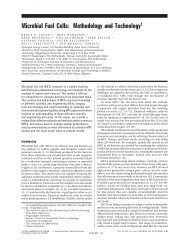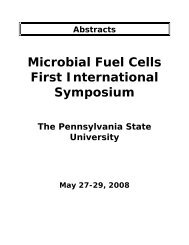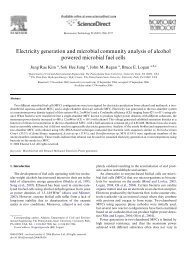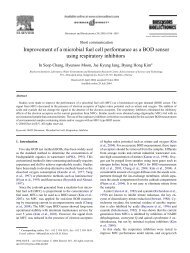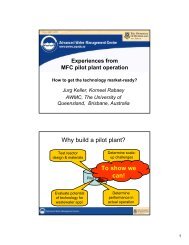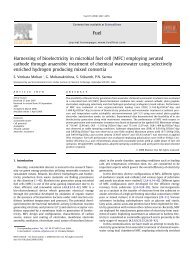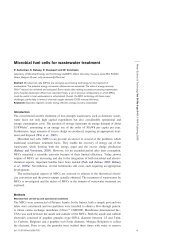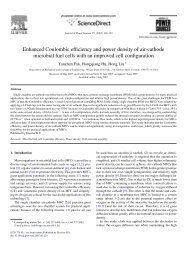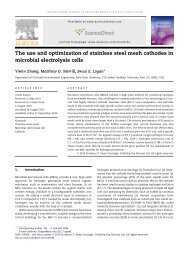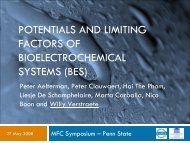Power from marine sediment fuel cells: the influence of anode material
Power from marine sediment fuel cells: the influence of anode material
Power from marine sediment fuel cells: the influence of anode material
You also want an ePaper? Increase the reach of your titles
YUMPU automatically turns print PDFs into web optimized ePapers that Google loves.
J Appl Electrochem (2008) 38:1313–1319 1319<br />
system <strong>of</strong> agitation to simulate <strong>the</strong> sea currents should be<br />
carried out.<br />
5 Conclusions<br />
Microbial <strong>fuel</strong> <strong>cells</strong> which utilise <strong>sediment</strong>s <strong>from</strong> ocean<br />
floors have been demonstrated using different carbon<br />
<strong>anode</strong>s: carbon sponge, carbon cloth, carbon fibre, graphite<br />
and reticulated vitreous carbon. After a period <strong>of</strong> stabilisation,<br />
open circuit potentials between 600–700 mV were<br />
observed for most <strong>cells</strong>. Steady state polarisations typically<br />
gave maximum peak power densities <strong>of</strong> 55 mW m -2 for<br />
carbon sponge <strong>anode</strong>s, which was more than double that<br />
achieved with carbon cloth and graphite. These latter<br />
<strong>material</strong>s typically gave power densities <strong>of</strong> around<br />
20 mW cm -2 . The performance <strong>of</strong> <strong>the</strong> cell was reduced by<br />
operation at a low temperature <strong>of</strong> 5 °C. Generally, for <strong>cells</strong><br />
which generated power at current densities <strong>of</strong> 100 mA m -2<br />
and greater, mass transport was found to limit <strong>anode</strong> and<br />
cathode performance, due primarily to low concentrations<br />
<strong>of</strong> oxygen and electro-active species present or generated<br />
in <strong>cells</strong>. The MFCs gave sustained power under constant<br />
load operation.<br />
Acknowledgements The support <strong>of</strong> <strong>the</strong> European Union for<br />
Transfer <strong>of</strong> Knowledge award (MTKD-CT-2004-517215) for biological<br />
<strong>fuel</strong> <strong>cells</strong> and DSTL under contract no. RD033-03223 is<br />
acknowledged.<br />
3. Reimers CE, Tender LM, Fertig S, Wang W (2001) Environ Sci<br />
Technol 35:192<br />
4. Tender LM, Reimers CE, Stecher HA, Holmes DE, Bond DR,<br />
Lowy DA, Pilobello K, Fertig SJ, Lovley DR (2002) Nat Biotechnol<br />
20:821<br />
5. Cooney MJ, Roschi E, Marison W, Comninellis C, von Stockar U<br />
(1996) Enzyme Microb Technol 18:358<br />
6. Habermann W, Pommer EH (1990) Appl Microbiol Biotechnol<br />
35:128<br />
7. Kim BH, Kim HJ, Hyun MS, Park DS (1999) J Microbiol Biotechnol<br />
9:127<br />
8. Kim HJ, Park HS, Hyun MS, Chang IS, Kim M, Kim BH (2002)<br />
Enzyme Microb Technol 30:145<br />
9. Park HS, Kim BH, Kim HS, Kim HJ, Kim GT, Kim M, Chang IS,<br />
Park YK, Chang HI (2001) Anaerobe 7:297<br />
10. Pham CA, Jung SJ, Phung NT, Lee J, Chang IS, Kim BH, Yi H,<br />
Chun J (2003) FEMS Microbiol Ecol 223:129<br />
11. Chaudhuri SK, Lovley DR (2003) Nat Biotechnol 21:1229<br />
12. Holmes DE, Bond DR, Lovley DR (2004) Appl Environ<br />
Microbiol 70:1234<br />
13. Bond DR, Lovley DR (2003) Appl Environ Microbiol 69:1548<br />
14. Lowy DA, Tender LM, Zeikus JG, Park DH, Lovley DR (2006)<br />
Biosens Bioelectron 21:2058<br />
15. Dawn E, Holmes Nicoll JS, Bond DR, Lovley DR (2004) Appl<br />
Environ Microbiol 70:6023<br />
16. Logan B, Cheng S, Watson V, Estadt G (2007) Environ Sci<br />
Technol 41:3341<br />
17. Qiao Y, Li CM, Bao SJ, Bao QL (2007) J <strong>Power</strong> Sources 170:79<br />
18. Cheng SA, Logan BE (2007) Electrochem Comm 9:492<br />
19. Hill A (ed) The Sea, vol 1, chap 1 and vol 4, pt 1, chap 18. Wiley<br />
20. Pletcher D, Walsh FC (1993) Industrial electrochemistry. Chapman<br />
and Hall<br />
References<br />
1. Bond DR, Holmes DE, Tender LM, Lovley DR (2002) Science<br />
295:483<br />
2. Holmes DE, Bond DR, O’Neil RA, Reimers CE, Lovley DR<br />
(2004) Microb Ecol 48(2):178–190, Aug 2004 48:178<br />
123



